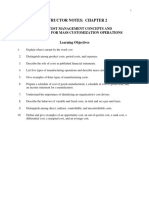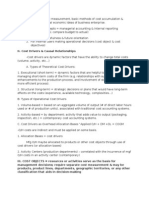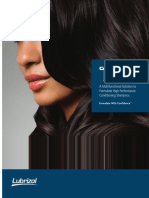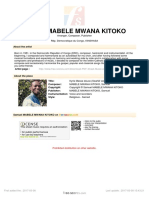0 ratings0% found this document useful (0 votes)
20 viewsCost Accounting - Studyblr
Cost Accounting - Studyblr
Uploaded by
Aryadna Sandi Cimarra1. The document describes a manufacturer that converts raw materials into finished goods using people and machines. It tracks inventory through three accounts: raw materials, work in process, and finished goods.
2. Service companies may also use inventory accounts for supplies and work in process as they convert labor and other inputs into tangible or intangible outputs.
3. Costs are classified as direct materials, direct labor, or overhead and tracked as product costs, period costs, or distribution costs depending on their nature and timing.
Copyright:
© All Rights Reserved
Available Formats
Download as PDF, TXT or read online from Scribd
Cost Accounting - Studyblr
Cost Accounting - Studyblr
Uploaded by
Aryadna Sandi Cimarra0 ratings0% found this document useful (0 votes)
20 views1 page1. The document describes a manufacturer that converts raw materials into finished goods using people and machines. It tracks inventory through three accounts: raw materials, work in process, and finished goods.
2. Service companies may also use inventory accounts for supplies and work in process as they convert labor and other inputs into tangible or intangible outputs.
3. Costs are classified as direct materials, direct labor, or overhead and tracked as product costs, period costs, or distribution costs depending on their nature and timing.
Original Title
Cost Accounting- Studyblr
Copyright
© © All Rights Reserved
Available Formats
PDF, TXT or read online from Scribd
Share this document
Did you find this document useful?
Is this content inappropriate?
1. The document describes a manufacturer that converts raw materials into finished goods using people and machines. It tracks inventory through three accounts: raw materials, work in process, and finished goods.
2. Service companies may also use inventory accounts for supplies and work in process as they convert labor and other inputs into tangible or intangible outputs.
3. Costs are classified as direct materials, direct labor, or overhead and tracked as product costs, period costs, or distribution costs depending on their nature and timing.
Copyright:
© All Rights Reserved
Available Formats
Download as PDF, TXT or read online from Scribd
Download as pdf or txt
0 ratings0% found this document useful (0 votes)
20 views1 pageCost Accounting - Studyblr
Cost Accounting - Studyblr
Uploaded by
Aryadna Sandi Cimarra1. The document describes a manufacturer that converts raw materials into finished goods using people and machines. It tracks inventory through three accounts: raw materials, work in process, and finished goods.
2. Service companies may also use inventory accounts for supplies and work in process as they convert labor and other inputs into tangible or intangible outputs.
3. Costs are classified as direct materials, direct labor, or overhead and tracked as product costs, period costs, or distribution costs depending on their nature and timing.
Copyright:
© All Rights Reserved
Available Formats
Download as PDF, TXT or read online from Scribd
Download as pdf or txt
You are on page 1of 1
Manufacturer engaged in a high degree of conversion of raw
material input into a tangible output using people and
machines. It uses three inventory accounts: (1) Raw Material
Inventory, (2) Work in Process Inventory, and (3) Finished
Goods Inventory.
Cost- monetary measure of resources given up to attain an Service Company uses a significant amount of labor to
objective such as making a good or delivering a service. engage in a high or moderate degree of conversion, whose
a. Unexpired Cost- portion of an asset’s value that has outputs can be tangible or intangible. Some service firms use
not yet been consumed. Reported on the balance two accounts (a Supplies Inventory account and a Work in
sheet as an asset. Process Inventory account) to accumulate these costs.
b. Expired Cost- portion of an asset’s value that has
been consumed. Reported as an expense on the i. Work not started (raw material);
income statement. ii. Work started but not completed (work in process); and
iii. Work completed (finished goods).
Cost Management System- a set of formal methods
developed for planning and controlling an organization’s cost- 1. Direct Material- includes the direct cost of all
generating activities relative to its strategy, goals, and materials used to manufacture a product or perform
objectives. a service.
2. Direct Labor- refers to the effort of individuals who
1. Association with cost object: manufacture a product or perform a service.
[Cost object- anything for which management wants 3. Overhead- any factory or production cost that is
to collect or accumulate costs.] indirect to manufacturing a product or providing a
a. Direct Costs- conveniently and economically service. Includes the costs of indirect material,
traceable to the cost object. indirect labor paid on an hourly basis, lubricants
b. Indirect Costs- non-traceable but must be used for machine maintenance, and the variable
allocated to the cost object. portion of factory utility charges.
a. Variable overhead- includes the costs of indirect
2. Reaction to changes in activity: material, indirect labor paid on an hourly basis,
[Relevant Range- assumed range of activity that lubricants used for machine maintenance, and
reflects the company’s normal operating range.] the variable portion of factory utility charges.
a. Variable Cost- fluctuates in total, directly b. Fixed overhead- includes costs such as straight-
proportionate when activity changes but line depreciation on factory assets, factory
constant on unit basis. license fees, factory insurance and property
b. Fixed Cost- remains constant in total when taxes, and fixed indirect labor costs.
activity changes but inversely proportional on
unit basis. Prevention costs- are costs to prevent product
c. Step Cost- cost that shifts upward and defects.
downward when activity changes by certain Appraisal costs- are costs for monitoring or
interval or “step.” This can be variable or fixed; inspecting products in order to find mistakes not
step variable costs have small steps while fixed eliminated through prevention.
costs have large steps. Internal Failure costs- are costs such as scrap and
d. Mixed Cost- both variable and fixed and must be rework before the product reaches the final
separated in order to make valid estimates. customer.
External Failure costs- are costs after the product
A. Predictor- an activity measure that, when has been delivered to the final customer and include
changed, is accompanied by consistent, costs such as product returns and warranty claims.
observable changes in a cost item.
B. Cost Driver- a predictor that has an absolute Cost allocation- the assignment of an indirect cost to
cause-and-effect relationship with the cost in one or more cost objects using driver.
question.
3. Classification on the Financial Statements: 1. Actual Cost System- actual direct material and direct
A. Product Costs or Inventoriable Costs- related to labor costs are accumulated in Work in Process
making or acquiring the products or providing (WIP) Inventory as the costs are incurred.
the services that directly generate the revenues 2. Normal Cost System- actual direct material and
of an entity. direct labor costs and an estimated amount of
a.a. Direct material- any material that can be overhead (assigned using a predetermined overhead
easily and economically traced to a product. rate or rates) are accumulated in WIP.
a.b. Direct labor- refers to the time spent by Predetermined Overhead Rate- (or overhead
individuals who work specifically on application rate) is a charge per unit of activity that is
manufacturing a product or performing a used to allocate (or apply) overhead cost from the
service. Overhead Control account to WIP Inventory for the
a.c. Overhead- any factory or production cost period’s production or services.
that is indirect (i.e., not direct material or direct
labor) to the product or service. Cost of Goods Manufactured= Beg. WIP + Direct
Conversion cost- the sum of direct Materials + Direct Labor + Overhead Costs – End.
labor and overhead costs. WIP
Prime cost- the sum of direct material Direct Materials= Beg. Raw Materials + Raw
and direct labor cost. Materials Purchases – End. Raw Materials
B. Period Costs- are related to business functions Cost of Goods Sold= Beg. Finished Goods Inventory +
other than production, such as selling and Cost of Goods Manufactured – End. Finished Goods
administration. It is generally more closely Inventory
associated with a particular time period.
C. Distribution costs- are period costs incurred to
warehouse, transport, or deliver a product or
service.
You might also like
- Cost Accounting Reviewer Chapter 1-4Document10 pagesCost Accounting Reviewer Chapter 1-4hanaNo ratings yet
- Caste and Class in A Southern Town by John Dollard PDFDocument484 pagesCaste and Class in A Southern Town by John Dollard PDFRavanan AmbedkarNo ratings yet
- Job-Order Costing and Modern Manufacturing PracticesDocument32 pagesJob-Order Costing and Modern Manufacturing PracticesPriyadarshi Saini100% (1)
- CH 02Document40 pagesCH 02lyonanh289No ratings yet
- Fima PrelimDocument9 pagesFima PrelimCharles IldefonsoNo ratings yet
- Cost Accounting REVIEWERDocument4 pagesCost Accounting REVIEWERMelissa SenonNo ratings yet
- ModuleNo1 BasicConceptsDocument4 pagesModuleNo1 BasicConceptsLyerey Jed MartinNo ratings yet
- Part III-Managerial AccountingDocument91 pagesPart III-Managerial AccountingGebreNo ratings yet
- 25885110Document21 pages25885110Llyana paula SuyuNo ratings yet
- Chapter 1Document3 pagesChapter 1Xyra ArsolerNo ratings yet
- Cost Accounting - Guerrerro Notes: Chapter 1-Cost Accounting - Basic Concepts and Job Order Cost CycleDocument6 pagesCost Accounting - Guerrerro Notes: Chapter 1-Cost Accounting - Basic Concepts and Job Order Cost CycleAyraaahNo ratings yet
- Cost AccountingDocument4 pagesCost AccountingNikki WanoNo ratings yet
- ACTG 22A-Cost Accounting and Control-ReviewerDocument8 pagesACTG 22A-Cost Accounting and Control-ReviewerLolli PopNo ratings yet
- Cost Concept and ClassificationDocument45 pagesCost Concept and ClassificationMountaha0% (1)
- Cost Concepts HandoutDocument5 pagesCost Concepts HandoutNovilyn LeonardoNo ratings yet
- Notes in Strategic Cost Management (SLPO)Document7 pagesNotes in Strategic Cost Management (SLPO)Laila OlpindoNo ratings yet
- Cost Sheet NotesDocument15 pagesCost Sheet NotesPratiksha SardaNo ratings yet
- AE22 Cost Accounting and Control - 3Document29 pagesAE22 Cost Accounting and Control - 3Ma. Franceska Loiz T. RiveraNo ratings yet
- Cost Accounting and ControlDocument14 pagesCost Accounting and Controlkaye SagabaenNo ratings yet
- Basic Cost ConceptsDocument2 pagesBasic Cost ConceptsdannaalissezabatNo ratings yet
- Chap 2Document9 pagesChap 2worknehNo ratings yet
- Basic Cost Management ConceptsDocument4 pagesBasic Cost Management ConceptsElvie Abulencia-BagsicNo ratings yet
- CH 2 Cost Concepts and BehaviorDocument37 pagesCH 2 Cost Concepts and BehaviorRexmar Christian BernardoNo ratings yet
- c1 - Introduction To Cost AccountingDocument2 pagesc1 - Introduction To Cost AccountingAndrea Camille AquinoNo ratings yet
- TransDocument2 pagesTransXyra ArsolerNo ratings yet
- Chapter 2 Hilton 10th Instructor NotesDocument10 pagesChapter 2 Hilton 10th Instructor NotesKD MV100% (2)
- 2B - Unit 2 - Cost Classification Behaviour & Estimation - Workbook SOLUTIONS - 2022Document47 pages2B - Unit 2 - Cost Classification Behaviour & Estimation - Workbook SOLUTIONS - 2022Bono magadaniNo ratings yet
- Chapter 2 Cost Terms Concepts and ClassificationsDocument51 pagesChapter 2 Cost Terms Concepts and ClassificationsMulugeta Girma100% (1)
- Cost Accounting and Control Lecture NotesDocument11 pagesCost Accounting and Control Lecture Notesdphoenix0802No ratings yet
- CH 02Document40 pagesCH 02hoangmyduyennguyen2004No ratings yet
- Cost Accounting ReviewerDocument6 pagesCost Accounting ReviewerAngela AcompañadoNo ratings yet
- Operations Management-Cost Measurement Methods & TechniquesDocument6 pagesOperations Management-Cost Measurement Methods & TechniquesjbphamNo ratings yet
- Systems Design: Activity-Based Costing and Management: MANAGEMENT ACCOUNTING-Solutions ManualDocument15 pagesSystems Design: Activity-Based Costing and Management: MANAGEMENT ACCOUNTING-Solutions ManualBianca LizardoNo ratings yet
- Notes On Classification of Costs and Cost ConceptsDocument5 pagesNotes On Classification of Costs and Cost ConceptsAngela Mae Balanon RafananNo ratings yet
- Cost TerminologyDocument2 pagesCost TerminologyChristine TutorNo ratings yet
- Cost Accounting and Job OrderDocument2 pagesCost Accounting and Job OrderRachelle MarteNo ratings yet
- MS 2Document8 pagesMS 2gabprems11No ratings yet
- Masr2205 - Cost Definition, Concepts, Classification & AnalysisDocument11 pagesMasr2205 - Cost Definition, Concepts, Classification & AnalysisDaniela AubreyNo ratings yet
- Job Order Costing QuizletDocument2 pagesJob Order Costing Quizletagm25No ratings yet
- KLi Notes - Basic Cost Flow TermsDocument8 pagesKLi Notes - Basic Cost Flow TermsJudith GarciaNo ratings yet
- Cost Terminology and Cost Behaviors: Learning ObjectivesDocument17 pagesCost Terminology and Cost Behaviors: Learning ObjectivesRichard John EcalneNo ratings yet
- Cost Terminology and Cost Behaviors: Learning ObjectivesDocument17 pagesCost Terminology and Cost Behaviors: Learning ObjectivesJonnah ArriolaNo ratings yet
- MS Reviewer QEDocument11 pagesMS Reviewer QEtouchglory2No ratings yet
- Cost NOTES - MIDTERMDocument33 pagesCost NOTES - MIDTERMChenary Magne FetalsanaNo ratings yet
- Cost Accounting RefresherDocument16 pagesCost Accounting RefresherDemi PardilloNo ratings yet
- Managerial Accounting and Cost - Part 01Document1 pageManagerial Accounting and Cost - Part 01Sittie Sarah BangonNo ratings yet
- Basic Cost Management ConceptsDocument7 pagesBasic Cost Management ConceptsImadNo ratings yet
- ACCT102 II Cheat SheetDocument3 pagesACCT102 II Cheat SheetJanice OwusuNo ratings yet
- Cost: As A Resource Sacrificed or Forgone To Achieve A Specific Objective. It Is Usually MeasuredDocument19 pagesCost: As A Resource Sacrificed or Forgone To Achieve A Specific Objective. It Is Usually MeasuredTilahun GirmaNo ratings yet
- COST I Chapter - 3&4Document30 pagesCOST I Chapter - 3&4alemuayalew01No ratings yet
- Module 5 Job Order CostingDocument5 pagesModule 5 Job Order CostingSky SoronoiNo ratings yet
- Cost AccountingDocument11 pagesCost AccountingWilbert Cunanan CapatiNo ratings yet
- LH - 02 - CAC - Cost Concepts and ClassficationDocument16 pagesLH - 02 - CAC - Cost Concepts and ClassficationDexter CanietaNo ratings yet
- Cac NotesDocument14 pagesCac Notescoco credo100% (1)
- Factory Overhead Costing and ControlDocument20 pagesFactory Overhead Costing and ControlAyesha JavedNo ratings yet
- Test Bank-Cost Concepts, Job Order, Materials, Service CostsDocument100 pagesTest Bank-Cost Concepts, Job Order, Materials, Service CostsKatrina Peralta FabianNo ratings yet
- Managerial AccountingDocument16 pagesManagerial AccountingLinh ChiNo ratings yet
- Cost Accounting 1 8 PDFDocument110 pagesCost Accounting 1 8 PDFHashim Mahmood KhanNo ratings yet
- Cost Concepts: Ilene D. Padilla Cpa, MbaDocument53 pagesCost Concepts: Ilene D. Padilla Cpa, Mbaharley_quinn11No ratings yet
- Learning Activity 1-1 - INTRODUCTION TO COST ACCOUNTING, SCOPE, AND OBJECTIVES OF COST ACCOUNTINGDocument6 pagesLearning Activity 1-1 - INTRODUCTION TO COST ACCOUNTING, SCOPE, AND OBJECTIVES OF COST ACCOUNTINGRegina PhalangeNo ratings yet
- 2019-Municipality of Tupi v. FaustinoDocument16 pages2019-Municipality of Tupi v. FaustinoChasmere MagloyuanNo ratings yet
- Shelving and Fire Codes: 3.9 Storage Definitions 3.9.1.4 CatwalkDocument3 pagesShelving and Fire Codes: 3.9 Storage Definitions 3.9.1.4 CatwalkkuraimundNo ratings yet
- Course of Study of Various Branches For Registration 2021-2023Document469 pagesCourse of Study of Various Branches For Registration 2021-2023gkkumarNo ratings yet
- 1st PT in DraftingDocument4 pages1st PT in DraftingGilbert Gabrillo Joyosa0% (1)
- LBZPC Carbopol-Silk Brochure TDS-947 2014 Hubcast FNLDocument4 pagesLBZPC Carbopol-Silk Brochure TDS-947 2014 Hubcast FNLOnesany TecnologiasNo ratings yet
- Ircam640: Ir Thermo CameraDocument2 pagesIrcam640: Ir Thermo Camerajehan11No ratings yet
- FS700 9b2007e PDFDocument36 pagesFS700 9b2007e PDFBd MahabubNo ratings yet
- Charles CorreaDocument15 pagesCharles Correaankitha100% (1)
- (FREE PDF Sample) Android Studio 3 0 Development Essentials Android 8 Edition Neil Smyth EbooksDocument62 pages(FREE PDF Sample) Android Studio 3 0 Development Essentials Android 8 Edition Neil Smyth Ebookszenkadrocus100% (2)
- Milk Bottle Seals Chapter 1Document14 pagesMilk Bottle Seals Chapter 1gethappo25No ratings yet
- MAT 2165 Lecture 6Document8 pagesMAT 2165 Lecture 69cvxx9nqbfNo ratings yet
- The Wizards of Once PDFDocument3 pagesThe Wizards of Once PDFdavid bennyNo ratings yet
- LikelyDocument2 pagesLikelyМасума МирзаходжиеваNo ratings yet
- Hiragana WorksheetsDocument7 pagesHiragana WorksheetsWesCampbell100% (1)
- Pr9903 - Specification For Building and Structural Works PDFDocument74 pagesPr9903 - Specification For Building and Structural Works PDFMark Anthony AcangNo ratings yet
- Performance Appraisal and 360 DegreeDocument2 pagesPerformance Appraisal and 360 DegreeHosahalli Narayana Murthy PrasannaNo ratings yet
- Game of Life ETEC 526Document27 pagesGame of Life ETEC 526Kristin McCloskeyNo ratings yet
- (Free Scores - Com) Mabele Mwana Kitoko Samuel Kyrie Messe Douce Swahili Version 103258Document2 pages(Free Scores - Com) Mabele Mwana Kitoko Samuel Kyrie Messe Douce Swahili Version 103258Alsace Elget TCHIBOUKANo ratings yet
- 800MW DPR - Electrical CommentsDocument2 pages800MW DPR - Electrical CommentsrukmagoudNo ratings yet
- C BookDocument118 pagesC BookpeterNo ratings yet
- Economics 204 Fall 2012 Problem Set 5 Suggested SolutionsDocument8 pagesEconomics 204 Fall 2012 Problem Set 5 Suggested SolutionsFunWithNumbers88No ratings yet
- Module 1 Activity 2Document1 pageModule 1 Activity 2Ayera Dicali100% (1)
- Free Amigurumi Frog PatternDocument9 pagesFree Amigurumi Frog PatternTatiana M. G.No ratings yet
- Top 20 JIRA Interview Questions (2023) - Javatpoint PDFDocument31 pagesTop 20 JIRA Interview Questions (2023) - Javatpoint PDFabenezerNo ratings yet
- Compliance Matters enDocument24 pagesCompliance Matters enElona LazajNo ratings yet
- 15bee0247 VL2018191002410 AdlDocument1 page15bee0247 VL2018191002410 AdlNishant KamalNo ratings yet
- 03 Rubrik Tugasan BMCDocument2 pages03 Rubrik Tugasan BMCIrwanie SharmeilaNo ratings yet
- BMW Innovations & RNDDocument7 pagesBMW Innovations & RNDVishal RamrakhyaniNo ratings yet
- Unit 4 - DecimalsDocument6 pagesUnit 4 - DecimalsRashed MiahNo ratings yet

























































































